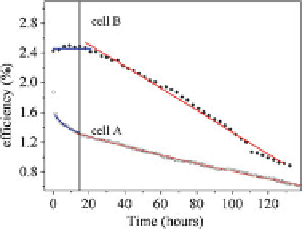Environmental Engineering Reference
In-Depth Information
Fig. 6.3 In situ EDXRR
measurements of the solar
cells, collected under
controlled atmosphere and
upon illumination. The
reflectivity profiles are shifted
in height for clarity. Inset: the
ex situ EDXRR
measurements carried out at a
distance of several months on
the same cell [
50
]. (Reprinted
with permission from Ref.
[
50
]. Copyright [2005],
American Institute of
Physics)
Fig. 6.4 Efficiency curves
for cell A and cell B [
51
].
(Reprinted with permission
from Ref. [
51
]. Copyright
[2006], American Institute
of Physics)
situ EDXRR measurements without any complementary technique for additional
study on morphology and structure.
However, there is a contradictory discussion that Andreasen et al. [
52
] cannot
correlate the fast degradation of OPVs to a substantial change of morphology,
verified by XRR technique, instead the authors found that rough interfaces of
stacking layers significantly inhibits the resolution of the XRR technique for in situ
investigation on physical degradation mechanisms, implying that it is difficult to
detect the changes at the interface of multiple layer-based OPVs (ITO/PE-
DOT:PSS/MEH-PPV:PCBM or P3HT:PCBM/Al) although different model fittings
have been applied.
XPS is a quantitative spectroscopic technique measuring the elemental
composition, empirical formula, chemical state, and electronic state of the elements
in a material, which is performed under ultra-high vacuum. XPS is used to analyze


Search WWH ::

Custom Search